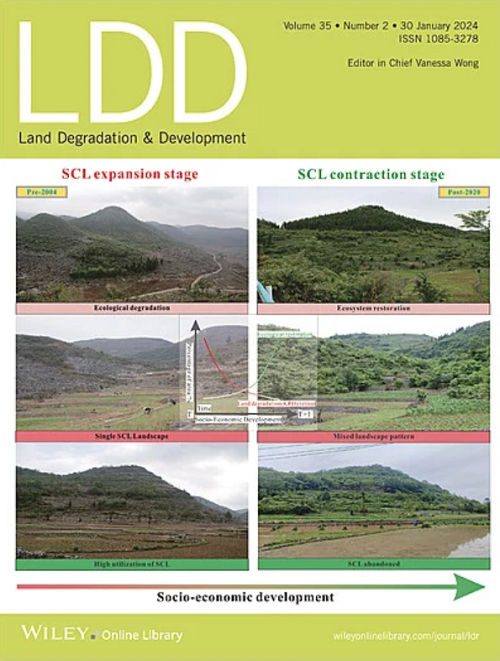Multivariate Controls of Water–Carbon Coupling Relationship Under Various Land Use Types in the Thick Loess Deposits
IF 3.6
2区 农林科学
Q2 ENVIRONMENTAL SCIENCES
引用次数: 0
Abstract
Prior studies have conducted extensive investigations of the water–carbon coupling relationship for aboveground vegetation and shallow soils, but the characteristics and multivariate controls in deep soils have not been fully explored. This has important implications for better understanding the water and carbon cycles of ecosystems. In this study, we attempted to examine the water–carbon coupling relationship in 18 m profiles under farmland (F), grassland (G), willow (SP), and poplar (P) in China's Loess Plateau. Specially, the multivariate controls of the water–carbon coupling relationship at diverse depths and scales were explored via the wavelet analysis. Individually, the conversion from F to G, SP, and P decreased the soil water storage within the 0–15 m by 553 (22% of F), 557 (22%), and 943 mm (38%). Land use change had little impact on soil organic or inorganic carbon. Even so, the poplar, compared with the willow, resulted in higher vertical variations in deep water and carbon. Furthermore, land use conversion increased the coherence between soil water and carbon in the whole layer. In comparison to F, which was dominated by water retention, G, SP, and P exhibited dominant carbon sequestration. The poplar reduced the root‐mean‐square deviation between soil water and organic carbon from 0.29 (F) to 0.13 in the 6‐ to 15‐m layer and between soil water and inorganic carbon from 0.32 (F) to 0.20 in the 0‐ to 2‐m layer. Sand content and electrical conductivity both played negative roles in maintaining water and carbon in the 6‐ to 15‐m and 0‐ to 15‐m layers at different scales, respectively. This study endeavors to present a novel viewpoint on land use management, with the potential to enhance ecosystem services in water‐limited and land‐degradation regions.求助全文
约1分钟内获得全文
求助全文
来源期刊

Land Degradation & Development
农林科学-环境科学
CiteScore
7.70
自引率
8.50%
发文量
379
审稿时长
5.5 months
期刊介绍:
Land Degradation & Development is an international journal which seeks to promote rational study of the recognition, monitoring, control and rehabilitation of degradation in terrestrial environments. The journal focuses on:
- what land degradation is;
- what causes land degradation;
- the impacts of land degradation
- the scale of land degradation;
- the history, current status or future trends of land degradation;
- avoidance, mitigation and control of land degradation;
- remedial actions to rehabilitate or restore degraded land;
- sustainable land management.
 求助内容:
求助内容: 应助结果提醒方式:
应助结果提醒方式:


